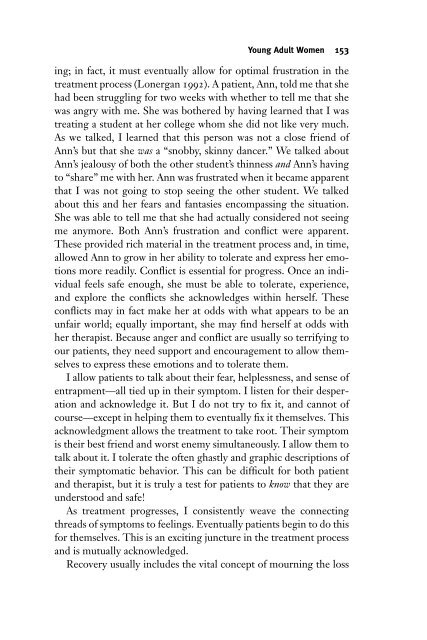Eating Disorders - fieldi
Eating Disorders - fieldi
Eating Disorders - fieldi
Create successful ePaper yourself
Turn your PDF publications into a flip-book with our unique Google optimized e-Paper software.
Young Adult Women 153<br />
ing; in fact, it must eventually allow for optimal frustration in the<br />
treatment process (Lonergan 1992). A patient, Ann, told me that she<br />
had been struggling for two weeks with whether to tell me that she<br />
was angry with me. She was bothered by having learned that I was<br />
treating a student at her college whom she did not like very much.<br />
As we talked, I learned that this person was not a close friend of<br />
Ann’s but that she was a “snobby, skinny dancer.” We talked about<br />
Ann’s jealousy of both the other student’s thinness and Ann’s having<br />
to “share” me with her. Ann was frustrated when it became apparent<br />
that I was not going to stop seeing the other student. We talked<br />
about this and her fears and fantasies encompassing the situation.<br />
She was able to tell me that she had actually considered not seeing<br />
me anymore. Both Ann’s frustration and conflict were apparent.<br />
These provided rich material in the treatment process and, in time,<br />
allowed Ann to grow in her ability to tolerate and express her emotions<br />
more readily. Conflict is essential for progress. Once an individual<br />
feels safe enough, she must be able to tolerate, experience,<br />
and explore the conflicts she acknowledges within herself. These<br />
conflicts may in fact make her at odds with what appears to be an<br />
unfair world; equally important, she may find herself at odds with<br />
her therapist. Because anger and conflict are usually so terrifying to<br />
our patients, they need support and encouragement to allow themselves<br />
to express these emotions and to tolerate them.<br />
I allow patients to talk about their fear, helplessness, and sense of<br />
entrapment—all tied up in their symptom. I listen for their desperation<br />
and acknowledge it. But I do not try to fix it, and cannot of<br />
course—except in helping them to eventually fix it themselves. This<br />
acknowledgment allows the treatment to take root. Their symptom<br />
is their best friend and worst enemy simultaneously. I allow them to<br />
talk about it. I tolerate the often ghastly and graphic descriptions of<br />
their symptomatic behavior. This can be difficult for both patient<br />
and therapist, but it is truly a test for patients to know that they are<br />
understood and safe!<br />
As treatment progresses, I consistently weave the connecting<br />
threads of symptoms to feelings. Eventually patients begin to do this<br />
for themselves. This is an exciting juncture in the treatment process<br />
and is mutually acknowledged.<br />
Recovery usually includes the vital concept of mourning the loss









